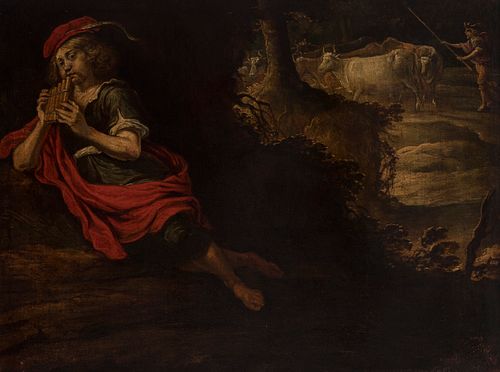Flemish school; Last third of the XVII century. "Shepherd with pan flute". Oil on canvas. Relined.
Lot 44
About Seller
Setdart Auction House
Carrer Aragó 346
Barcelona
Spain
Setdart Subastas was born in 2004 and is currently the first online art auction in Spain with solidity, prestige and reliability guaranteed by our more than 60,000 users. Setdart has a young, dynamic and enterprising team ready to successfully manage the purchase and sale of art works through custom...Read more
Estimate:
EUR€3,000 - EUR€4,000
$3,092.78 - $4,123.71
Absentee vs Live bid
Two ways to bid:
- Leave a max absentee bid and the platform will bid on your behalf up to your maximum bid during the live auction.
- Bid live during the auction and your bids will be submitted real-time to the auctioneer.
Bid Increments
| Price | Bid Increment |
|---|---|
| EUR€0 | EUR€10 |
| EUR€200 | EUR€25 |
| EUR€500 | EUR€50 |
| EUR€1,000 | EUR€100 |
| EUR€3,000 | EUR€200 |
| EUR€5,000 | EUR€500 |
| EUR€10,000 | EUR€1,000 |
| EUR€20,000 | EUR€2,000 |
| EUR€50,000 | EUR€5,000 |
About Auction
By Setdart Auction House
Oct 20, 2021
Set Reminder
2021-10-20 07:30:00
2021-10-20 07:30:00
America/New_York
Bidsquare
Bidsquare : OLD MASTERS
https://www.bidsquare.com/auctions/setdart-auction-house/old-masters-7700
Setdart Auction House sofia@setdart.com
Setdart Auction House sofia@setdart.com
- Lot Description
Flemish school; Last third of the XVII century. "Shepherd with pan flute". Oil on canvas. Relined. Size: 45 x 60 cm; 69,5 x 50,5 cm (frame). In this narrative scene, the author poses two independent images divided by two planes. In the main area, on the left, an elegantly dressed young man seems to rest and enjoy playing the siringa, also known as Pan's flute. In the right area of the scene, a young man leads the cattle. These two images seem contrary to each other, as one reflects the hard work of the countryside, while the other character represents the idyllic life of the countryside. However, the introduction of Pan's flute is the key to understanding the scene, since in Greek mythology, Pan was the god of shepherds and cattle. While in the 17th century the demand for religious art for churches radically ceased in the northern provinces, today's Holland, in Flanders a monumental art in the service of the Catholic Church flourished instead, partly due to the necessary restoration of the ravages that the wars had caused in churches and convents. In the field of secular art, Flemish painters worked for the court in Brussels and also for the other courts of Europe, producing a painting with classical, mythological and historical themes that was to decorate brilliantly the Royal Sites of Spain, France and England. Thus, there was a proliferation of works of medium and small format, with different themes perfectly framed in a wide range of genres, treated by specialized painters who often collaborated on the same work. In this work the landscape shows artistic characteristics based on the pictorial tradition of the Netherlands in the 15th century, which developed artistically in later centuries. Thus, in the 12th century the use of the landscape as a background for the works came to occupy a much more important place as an artistic element than that occupied by the landscape in other schools of the same period. As far as the representation of the narrative is concerned, the landscape of the Flemish primitives plays an essential role, not only as the natural environment of the characters but also to separate and set the various episodes of the story narrated in the work. As for the imitation of nature, the Flemish painters of the fifteenth century sought to represent in a plausible way in the landscapes of their religious paintings the fields and cities of their native country, detailing their flora with botanical precision and even giving an idea of the time of day and the season of the year in which the scene takes place as. thus establishing a pictorial pattern that continues until the seventeenth century as can be seen in this painting. This special interest in the representation of the landscape increased as the 16th century progressed, when a new type of landscape for sacred scenes was developed and popularized: the panoramic view.
- Shipping Info
-
In-house shipping available. Please inquire at admin@setdart.com.
-
- Buyer's Premium



 EUR
EUR CAD
CAD AUD
AUD GBP
GBP MXN
MXN HKD
HKD CNY
CNY MYR
MYR SEK
SEK SGD
SGD CHF
CHF THB
THB









